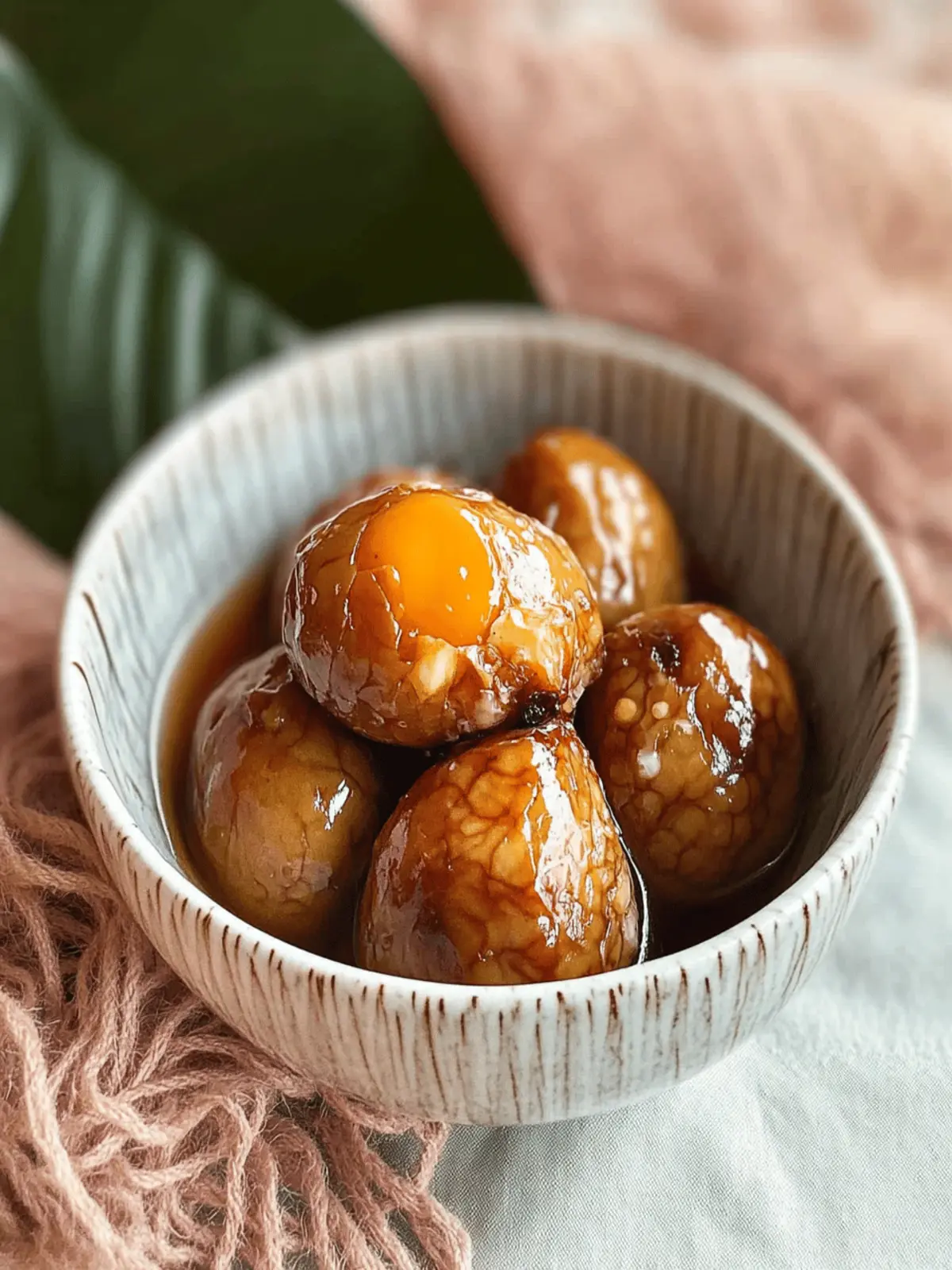When I first tried Tiger Skin Eggs, I was captivated by their unique combination of flavors and textures. Picture this: crisp, blistered exteriors giving way to tender, savory bites that truly elevate the humble hard-boiled egg to something extraordinary. The preparation—frying and braising—transforms these simple ingredients into a mouthwatering dish rich with history, tracing back to the Ming Dynasty.
I discovered this gem one evening when I decided to step away from my usual fast-food routine and explore more exciting flavors in my kitchen. The delightful aroma of ginger and garlic wafting through the air hinted that something special was on the horizon. Whether served on their own, or with a steaming bowl of rice, these Tiger Skin Eggs are not just easy to make; they’re a versatile crowd-pleaser that everyone will love. If you’re ready to bring a taste of authentic Chinese cuisine to your table, grab your apron, and let’s get cooking!
Why are Tiger Skin Eggs a must-try?
Versatile and Satisfying: These eggs are perfect for any meal, whether as a hearty main or a delightful side dish.
Bold Flavors: The frying and braising bring out rich, savory notes that tantalize your taste buds.
Easy Preparation: With simple steps and common ingredients, you can whip these up in no time.
Nutrient-Rich: Packed with protein and essential nutrients, they’ll keep you feeling energized and satisfied.
Cultural Tradition: Connecting us to ancient Chinese culinary practices, each bite offers a taste of history.
Impressive Presentation: The blistered exterior combined with a luscious sauce makes these eggs visually appealing, perfect for impressing guests.
Tiger Skin Eggs Ingredients
For the Eggs
- Fresh Eggs – Use medium-sized eggs for the best texture.
For the Frying
- Cooking Oil – Great options include vegetable or peanut oil for frying.
For the Braising Sauce
- Light Soy Sauce – This offers essential saltiness; choose low-sodium for a healthier meal.
- Dark Soy Sauce – Optional for depth; tamari can replace it for a gluten-free option.
- Chinese Cooking Wine – Enhances flavor; omit for an alcohol-free dish or substitute with rice vinegar.
- Rock Sugar – Balances flavors beautifully; regular sugar works if you’re in a pinch.
- Water – Necessary for achieving a delicious sauce consistency.
For the Aromatics
- Fresh Ginger – Adds a delightful aromatic quality; fresh is best!
- Garlic – Provides a rounded flavor; lightly smash for a gentler taste.
- Star Anise – Introduces a warm sweetness; feel free to substitute with a pinch of five-spice powder.
- Bay Leaf – Optional but recommended for added earthiness.
- Sichuan Peppercorns – Offers a hint of unique numbing spice; adjust to your taste.
For Thickening
- Cornstarch – Used for thickening the sauce; arrowroot powder can work as a substitute.
Embrace the delicious process of making Tiger Skin Eggs and watch as they turn into a gourmet feast in your very own kitchen!
How to Make Tiger Skin Eggs
-
Boil Eggs: Place the eggs in a pot of cold water. Bring to a gentle boil and cook for 6.5 minutes, then plunge them into icy water to cool quickly.
-
Prepare Eggs for Frying: Once cooled, gently tap and crack the eggshells all over. Dry the eggs thoroughly with a paper towel to minimize splatter during frying.
-
Fry Eggs: Heat a good amount of cooking oil in a pan over medium heat. Carefully add the eggs and fry for 90 seconds on each side until they develop a golden, blistered crust.
-
Sauté Aromatics: In a separate pan, heat a small bit of oil and sauté the ginger, garlic, and any spices you choose until they become fragrant, about 2-3 minutes.
-
Add Eggs and Sauce Ingredients: Transfer the fried eggs to the sauté pan. Pour in the light and dark soy sauces, Chinese cooking wine, rock sugar, and water. Stir to combine and let simmer uncovered for about 10 minutes.
-
Reduce Sauce: Check the sauce and let it reduce by a third, tasting it to adjust seasoning for your preference.
-
Thicken Sauce: Combine cornstarch with a splash of water until smooth, then stir this mixture into the sauce. Cook until it thickens slightly, about 2 minutes.
-
Garnish and Serve: Plate your Tiger Skin Eggs and garnish with sesame seeds and chopped chili for an extra kick. Serve hot alongside steamed rice.
Optional: Choose to sprinkle fresh scallions on top for a fresh finish.
Exact quantities are listed in the recipe card below.
What to Serve with Tiger Skin Eggs?
Bring your dining table to life with exciting pairings!
-
Steamed Jasmine Rice: The fluffy grains soak up the savory sauce, creating a comforting and satisfying meal.
-
Stir-Fried Bok Choy: Crisp and slightly sweet, this lightly sautéed veggie balances the richness of the eggs beautifully.
-
Cucumber Salad: Refreshing and crunchy, a simple vinegar-based salad adds a crisp contrast to the warm, savory flavors.
-
Garlic Noodles: Rich and savory noodles provide a deliciously comforting base that complements the tiger skin eggs perfectly.
-
Hot & Sour Soup: A warm bowl of this soup adds a spicy, tangy zing that elevates your meal to new heights.
-
Pickled Vegetables: Tangy and sharp, they cut through the richness of the eggs, enhancing your overall dining experience.
For an extra treat, consider pairing with a refreshing jasmine tea or a light dessert like mango sticky rice to finish on a sweet note. Each of these sides brings a unique element to your feast, crafting a well-rounded and unforgettable dining experience.
Tiger Skin Eggs Variations & Substitutions
Feel free to let your culinary creativity shine as you adapt this flavorful recipe to your taste and dietary needs.
- Spicy Kick: Add sliced fresh chili during the sauté step for an extra layer of heat that excites the palate.
- Herb Swap: Replace ginger with fresh scallions or cilantro for a vibrant twist that brings freshness to the dish.
- Vegan Version: Substitute eggs with tofu or tempeh for a plant-based alternative that soaks up the savory sauce beautifully.
- Citrus Zest: Incorporate a splash of lemon or orange juice into the braising liquid for a bright, zesty flavor.
- Sweet Addition: Mix in a handful of thinly sliced carrots or bell peppers with the aromatics for a sweet crunch that complements the savory notes.
- Noodle Dish: Toss the Tiger Skin Eggs onto a bed of cooked noodles for a filling meal that marries delicious textures.
- Smoky Flavor: Use smoked soy sauce instead of regular soy for a unique depth and aroma that will leave you wanting more.
- Instant Pot Option: Try boiling the eggs in an Instant Pot to save time; set it for 5 minutes on high pressure, then cool in ice water for the same effect.
These variations allow you to truly make this dish your own and enjoy a delightful dining experience every time!
Make Ahead Options
Tiger Skin Eggs are an excellent choice for those busy weeknights when time is of the essence! You can prepare the eggs by boiling and frying them up to 24 hours in advance. After frying, allow the eggs to cool and then store them in an airtight container in the refrigerator to maintain their quality. The braising sauce can also be made ahead of time and refrigerated for up to 3 days. When you’re ready to serve, simply reheat the sauce gently, add the pre-fried eggs, and let them simmer together until warmed through. This way, you’ll enjoy restaurant-quality Tiger Skin Eggs with minimal effort!
How to Store and Freeze Tiger Skin Eggs
Fridge: Store any leftover Tiger Skin Eggs in an airtight container in the fridge for up to 3 days. The flavors will deepen as they sit, making them even more delectable!
Freezer: While it’s best to enjoy Tiger Skin Eggs fresh, you can freeze them for up to 2 months. Wrap each egg tightly in plastic wrap and place in a freezer bag to prevent freezer burn.
Reheating: When ready to enjoy, thaw in the refrigerator overnight, then reheat gently in a pan over low heat until warmed through. Avoid high temperatures to maintain the egg’s texture.
Braising Sauce: If you have leftover braising sauce, store it separately in an airtight container in the fridge for up to 1 week. Reheat and use it as a dipping sauce when serving the eggs.
Expert Tips for Tiger Skin Eggs
- Dry Thoroughly: Ensure eggs are completely dry before frying to prevent dangerous splashes of hot oil.
- Gentle Frying: Rotate eggs carefully while frying for an even, golden color on all sides.
- Flavor Infusion: For an enhanced flavor, allow the braised eggs to sit overnight in the sauce before serving.
- Seasoning Check: Taste and adjust seasoning, especially with soy sauce, to avoid excessive saltiness in these Tiger Skin Eggs.
- Sauce Thickness: Stir cornstarch gradually into the sauce; adding too quickly can create lumps instead of a smooth texture.
Tiger Skin Eggs Recipe FAQs
How do I choose the right eggs for Tiger Skin Eggs?
Absolutely! For the best results, choose fresh, medium-sized eggs. Look for eggs with smooth, unblemished shells and a consistent color. This will ensure that they boil evenly and taste great.
What is the best way to store leftover Tiger Skin Eggs?
Very! Store any leftover Tiger Skin Eggs in an airtight container in the fridge for up to 3 days. The flavors will actually deepen over time, making them even more delicious when you reheat and serve them!
Can I freeze Tiger Skin Eggs, and how?
Yes, you can freeze them! Wrap each cooled egg tightly in plastic wrap, then place them in a sealed freezer bag to prevent freezer burn. They can be stored in the freezer for up to 2 months. When you’re ready to enjoy, thaw them in the refrigerator overnight and gently reheat in a pan over low heat.
What should I do if my sauce is too salty?
If you find your sauce is too salty, don’t worry! Add a splash of water or a little more sugar to balance the flavors. Alternatively, you can mix a small amount of cornstarch with water and stir it into the sauce to help mellow the saltiness and thicken it simultaneously.
Can I adjust this recipe for dietary restrictions?
Absolutely! To make Tiger Skin Eggs gluten-free, simply substitute light soy sauce with tamari. If you’re avoiding alcohol, you can either omit the Chinese cooking wine or use rice vinegar for a touch of acidity. Always ensure that the ingredients you select align with your specific dietary needs.
How can I enhance the flavor of the braising sauce?
The more the merrier! To enhance the sauce’s flavor, consider adding a pinch of five-spice powder along with the other aromatics. You can also let the braised eggs sit overnight in the sauce before serving; this not only intensifies the flavors but allows the eggs to absorb more goodness!

Savory Tiger Skin Eggs Recipe – A Delicious Twist on Tradition
Ingredients
Equipment
Method
- Place the eggs in a pot of cold water. Bring to a gentle boil and cook for 6.5 minutes, then plunge them into icy water to cool quickly.
- Once cooled, gently tap and crack the eggshells all over. Dry the eggs thoroughly with a paper towel to minimize splatter during frying.
- Heat a good amount of cooking oil in a pan over medium heat. Carefully add the eggs and fry for 90 seconds on each side until they develop a golden, blistered crust.
- In a separate pan, heat a small bit of oil and sauté the ginger, garlic, and any spices you choose until they become fragrant, about 2-3 minutes.
- Transfer the fried eggs to the sauté pan. Pour in the light and dark soy sauces, Chinese cooking wine, rock sugar, and water. Stir to combine and let simmer uncovered for about 10 minutes.
- Check the sauce and let it reduce by a third, tasting it to adjust seasoning for your preference.
- Combine cornstarch with a splash of water until smooth, then stir this mixture into the sauce. Cook until it thickens slightly, about 2 minutes.
- Plate your Tiger Skin Eggs and garnish with sesame seeds and chopped chili for an extra kick. Serve hot alongside steamed rice.











